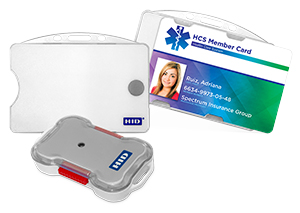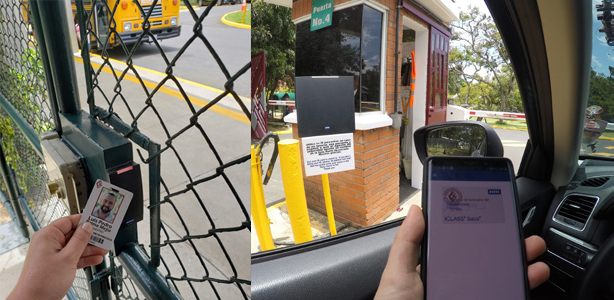How Duress Buttons Can Save Lives in Schools
On Monday March 27, 2023, a lone shooter entered a private elementary school in Nashville and took the lives of three nine-year-old children and three adults.
The tragedy of this latest school shooting deeply affects us all and underscores the constant vigilance required in American schools. Data compiled by The Washington Post reveals that there have been 376 school shootings in the past 24 years, exposing more than 348,000 students to gun violence since the Columbine High School shooting in 1999.
Whenever these tragedies occur, the public seeks answers, legislative changes and assurances that their own children will be protected in their places of learning.
How Can Schools Improve Safety and Security?
Matthew Johnson, VP Product IoT, HID, has personal experience of the anguish suffered by parents who learn that a live shooter is loose in their child’s school. He stresses how critical it is for schools to act within seconds to alert emergency services and lists three requirements to save lives when a live shooter is on the scene:
- Access control
- Emergency communications
- Bleed kits
Access Control
A combination of physical and electronic access control systems and strict visitor management policies provide the first line of defense to help schools to prevent dangerous individuals from entering their facilities. These measures include visitor management systems and door access controller platforms, which link physical access controls with cloud-based consoles, to provide real-time visibility of visitors entering and moving around the school premises.
Emergency Communications
In a recent HID webinar, Matthew Johnson draws from his own experience of the Parkland school shooting, which took place on February 14th, 2018, to explain why duress technology is critical in a live shooter incident. He describes how — within seven seconds — four people had been fatally shot and four were injured. After three minutes and 45 seconds, 17 people had been killed and 17 were seriously injured. Everyone in the school had mobile phones — and yet it took one minute and eight seconds before the first call was made to the emergency services.
Timeline is everything in a live shooter scenario. When people are traumatized, they freeze. People under duress cannot think clearly enough to make that call to emergency services and doing so, in the vicinity of a shooter, puts a caller’s life at risk. — Matthew Johnson, VP Product, IoT, HID
Why Wearable Panic Buttons are Critical in a Live Shooter Incident
Using technology developed to protect healthcare workers against violent assaults, HID’s wireless duress button is incorporated into a credit card-sized ID badge that integrates with 911/999/112 emergency call systems and internal security systems. With a single button press, emergency services are alerted that an incident is in progress. Importantly, the panic button can be pressed silently and discreetly, without alerting a perpetrator. In addition, HID’s real-time location system (RTLS) allows first responders to know exactly where the duress button was pressed, so that help reaches the injured more quickly and lock down procedures can be followed to isolate the area and reduce the risk of additional casualties. Panic-stricken people don’t have to think about dialing a number on their mobile phone. At the press of a button, emergency services know precisely where the incident is happening and where to send help. If a button is unintentionally activated, a double press cancels the call.
How HID Duress Solutions Work
Members of staff wear a credit card-sized badge containing an RFID chip and Bluetooth® Low Energy (BLE) transmitter. WiFi gateways, quickly and easily installed around the facility, receive real-time location data from the badges. The duress buttons can be inexpensively integrated with a school’s existing WiFi infrastructure.
For schools using the complete HID IoT solution, data from the wearable HID BEEKS™ duress beacons is processed by HID Bluzone™ software, hosted in the cloud or managed on-premise. HID BluFi™ Bluetooth LE to WiFi gateways allow BEEKS beacons to be centrally-managed within Bluezone, creating an end-to-end IoT system that provides full visibility of personnel and tracking of hall passes.
Floor plans can be easily imported into Bluzone to guide emergency services to the precise location of the incident and shooter. When an HID Bluetooth panic button is pressed, emergency services and security personnel know which member of staff has called for assistance and exactly where they are within the school campus, which also supports safe mustering procedures.
Why HID uses Bluetooth LE for Duress Solutions
Bluetooth LE uses the same 2.4GHz radio frequency as classic Bluetooth and doesn’t require line-of-sight with a reader. This means HID BEEKS duress beacons can transmit a user’s location through walls, with the advantage that the battery powering the antenna will last for up to five years. Facilities can use REST APIs to integrate Bluzone with custom dashboards and third-party software to enable duress solutions to be cost-effectively connected into other RTLS solutions such as wayfinding, people workflow and asset tracking solutions. This also allows battery life of the Bluetooth LE BEEKS beacons to be centrally monitored over a number of years, to provide reassurance to staff that their duress button will work in the event of an emergency.

How Door Access Control Systems Work
While physical and electronic door locks fitted to exterior entrances are the primary control mechanism for keeping intruders out, many fatal school shootings have been carried out by students who had legitimate reason to be on campus. In this scenario, electronic access controls fitted to interior doors play a vital role in isolating areas and saving lives.
Evacuation, lockdown or shelter in place procedures can be more easily followed by staff and the young people under their protection when centrally-controlled physical access control systems have been fitted to every classroom door.
The introduction of wireless control mechanisms has reduced the cost per unit for schools, while easing installation of individual electronic door locks, facilitating implementation of robust access control solutions across K-12 campuses.
How HID Helps Secure School Campuses
For decades, HID has helped to secure schools, hospitals and office buildings with a range of physical access control solutions ranging from entry-level smart card technologies to modern solutions, including HID Mobile Access® , which was implemented by Colegio Americano de Guatemala to verify students’ and visitors’ identities in real-time, manage access credentials and locate staff across its large campus. Drop off times have been halved and evacuation and emergency processes have been improved because the school now has an automated system to manage entry and exit of employees.
The HID K-12 system provides a combination of wireless electronic access control infrastructure and visitor management software, which is centrally controlled and can be configured to send text alerts to appropriate staff members and security personnel when individuals of note attempt to access the school premises.
To reduce administration overhead, the controller platform can be integrated with wireless electronic door locks and mobile phone credentials, to provision and revoke visitor access over the air. This level of centralized and granular control over electronic door locking/unlocking infrastructure, combined with real-time visibility of a visitor’s location, supports mustering procedures and saves vital seconds for first responders in a live shooter scenario.

HID offers a wide range of school safety and access control solutions to help keep students and staff safe.
Our solution is simplistic and scalable that comes in at an affordable cost, especially for cash-strapped public institutions such as K-12 schools. Not only does our solution provide teacher/staff with duress alerting, but we also enable other important tracking features such as hall passes, technology assets (e.g., student Chromebooks), and mustering at a pre-designated location (in case of an emergency such as a fire). There is no limit to what benefits we can provide to public school staff and students. — Kevin Mercer, Global Director of Sales, IoT Solutions, HID
Conclusion
While Congress continues to debate the tightening of gun controls, school principals must look at all other options to keep their students and staff safe.
Until that time, we send our sincere condolences to all students, families and friends of those affected by these crimes and will continue to play our part to protect our school communities.
To find out more about HID is working to protect school communities with IoT duress buttons, listen to our on-demand webinar, Protecting Healthcare Staff from Violence with RFID/RTLS >>
Josie Herbert is a freelance writer based in the UK.
